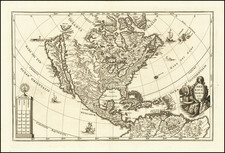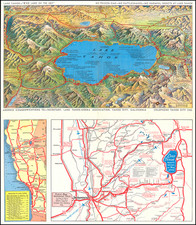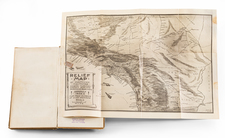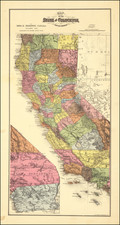Rare early map of the town of Napa, California, with a marvelous advertising broadside on the verso. The verso can be viewed through the following link: /gallery/enlarge/17947a.
The map was prepared in connection with the sale of 37 lots in the City of Napa, in the year following its reincorporation. The verso of the map shows 5 engraved views and a wonderful promotional tract describing the City of Napa and important local details. The City of Napa was founded by Nathan Coombs in 1847. The townsite was surveyed by James M. Hudspeth on property Coombs had received from Nicolas Higuerra, holder of the original Spanish Grant. Napa was incorporated in 1872 and reincorporated again in 1874 as the City of Napa. The present map is one of the earliest obtainable maps of any part of Napa and the earliest to focus on this part of the town.
The map is extremely rare. OCLC locates only one copy (Bancroft Library, UC Berkeley).
Grafton Tyler Brown, perhaps the first African American artist to depict California and the Pacific Coast, was born in Harrisburg, Pennsylvania, February 22, 1841. Before he was twenty, Brown moved to San Francisco and learned the art of lithography from C. C. Kuchel. In 1861 and again in 1864, Brown created the two earliest bird's eye views of Virginia City. At the age of twenty-six, he established his own firm, G.T. Brown & Co.
At San Francisco, and elsewhere in California, Brown produced skillfully illustrated bank notes, labels, and maps, and stock certificates for Wells Fargo, Levi Strauss and Co., and several mining companies. His significant lithographic production, The Illustrated History of San Mateo County (1878), featured seventy-two views of the county's communities and ranches. Brown traveled throughout Oregon, Washington, Idaho, Wyoming, Nevada, and British Columbia (where he settled in 1882), producing maps and illustrations, including many landscape paintings.
In 1893, Brown secured employment as a draftsman at the St. Paul, Minnesota office of the U.S. Army Corps of Engineers. Sometime during his St. Paul years he married Elberta Brown. Brown's work with the Corps of Engineers ended in December 1897, after which he worked in the civil engineering department of the city of St. Paul until 1910. He died on March 3, 1918, in Nicollet County, Minnesota, bringing to a close a rich and varied career as an artist and illustrator of the American West.











![Pacific Coast Highways Canada to Mexico [Texaco Tour Maps Routes and Mileages Canada to Mexico]](https://storage.googleapis.com/raremaps/img/small/91594.jpg)

![[Eastern San Diego County] Cuyamaca Quadrangle](https://storage.googleapis.com/raremaps/img/small/83422.jpg)
